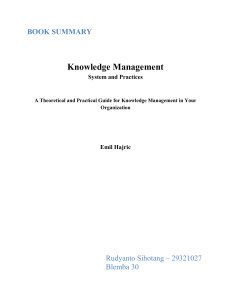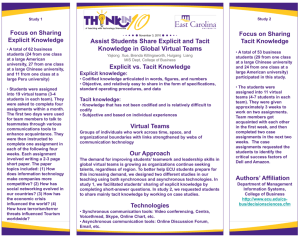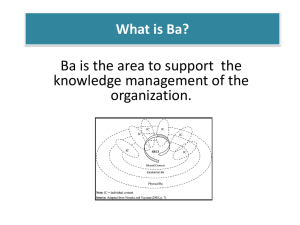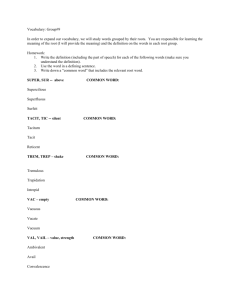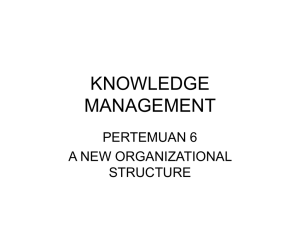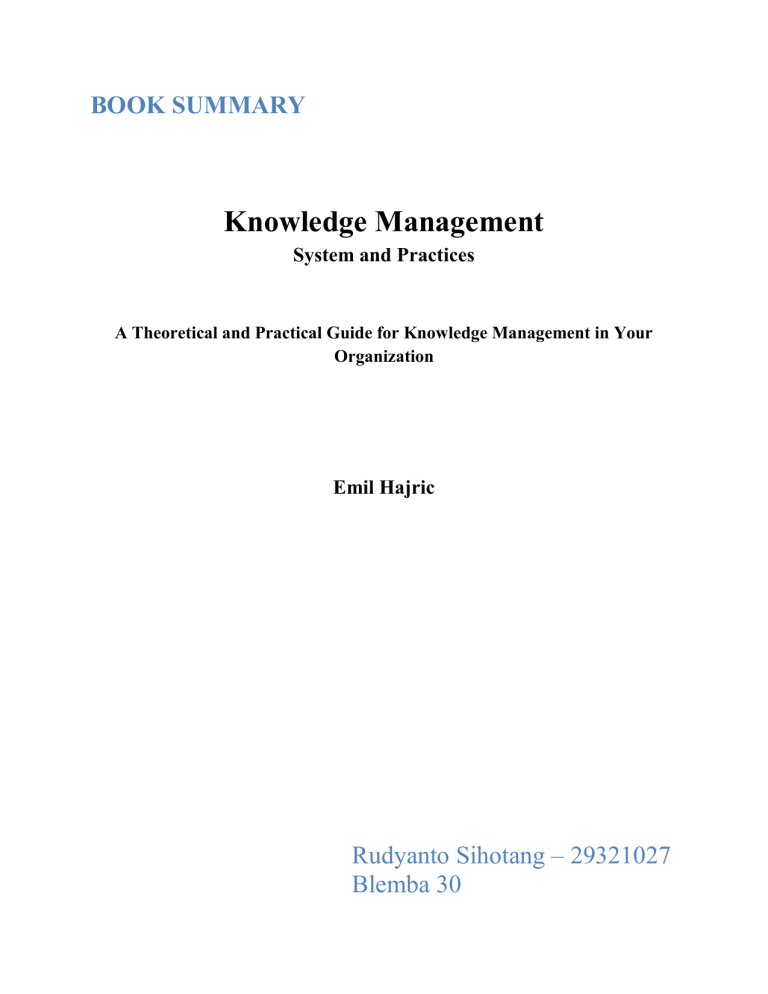
BOOK SUMMARY Knowledge Management System and Practices A Theoretical and Practical Guide for Knowledge Management in Your Organization Emil Hajric Rudyanto Sihotang – 29321027 Blemba 30 TABLE OF CONTENTS Knowledge, Information & Data .....................................................................................................3 What is Knowledge Management? ..................................................................................................3 Organizational Knowledge ..............................................................................................................4 Organizational Learning ..................................................................................................................5 Organizational Culture and Leadership ...........................................................................................6 Knowledge Management Models ....................................................................................................7 Knowledge Management Processes .................................................................................................8 Knowledge Management Strategy ...................................................................................................9 Knowledge Management Tools by Category (IT Based) ................................................................9 Knowledge Management Tools by Category (Non IT-Based) ......................................................10 Knowledge Management Failure ...................................................................................................10 Knowledge Management Careers and Skills .................................................................................11 2 Knowledge, Information & Data KM is concerned with getting the right knowledge to the right person, with the overall goal of creating value and leveraging and refining the firm's knowledge assets to achieve its objectives. It can be implemented in a variety of ways: Strategy, organizational culture, organizational process, management and leadership, technology, and politics are all topics covered in this course. Data are facts and figures that convey a certain message but are not arranged in any way. Information is data that has been contextualized, categorized, calculated, and condensed; knowledge is a fluid mix of framed experience, values, contextual information, expert insight, and grounded intuition that provides an environment and framework for evaluating and incorporating new experiences and information. Embedded not only in documents or repositories, but also in organizational routines, practices, and norms. There are three different sorts of knowledge. Explicit knowledge is formalized and codified knowledge that can be easily identified, stored, and retrieved. Implicit knowledge, often known as know-how, is a type of implicit knowledge. Refers to instinctive, difficult-to-define knowledge that is primarily based on experience; Embedded knowledge is knowledge that is embedded in processes, products, cultures, habits, and so on What is Knowledge Management? Knowledge management is the systematic management of an organization's knowledge assets for the purpose of creating value and meeting tactical and strategic requirements; it includes the initiatives, processes, strategies, and systems that support and improve knowledge storage, assessment, sharing, refinement, and creation. Knowledge management is beneficial since it emphasizes knowledge as a physical asset rather than an intangible. It aids firms in learning from past mistakes, better utilizing existing knowledge assets by redeploying them in areas where the firm stands to gain something, promoting a long-term focus on developing the right competencies and skills while eliminating obsolete knowledge, enhancing the firm's ability to innovate, and enhancing the firm's ability to protect its key knowledge and competencies from being lost. Information Management vs Knowledge Management Information Management Focus on data & information Technology driven Explicit Know What (facts, statistics, etc) Easy to copy 3 Knowledge Management Focus on Knowledge, understanding & wisdom People, process & management driven Tacit Know How (action, experience, innovation, etc) Hard to copy Organizational Knowledge There are five different levels on business knowledge: 1. Individual: Personal, often tacit knowledge. 2. Groups/community: there is knowledge sharing in groups but not shared with the rest of organization. 3. Structural: Embedded knowledge in the routines used by organization in processes, culture, and so forth. 4. Organizational: The resulting tacit and explicit knowledge used by various organization groups. 5. Extra-organizational knowledge: knowledge obtained outside of the organization that can be used to improve organizational performance. Knowledge management (KM) must be present throughout the knowledge spectrum. The understanding and management of organizational learning, organizational memory, knowledge sharing, knowledge creation, and organizational culture are critical to the success of KM. Nonaka and Takeuchi introduced the SECI model which has become the cornerstone of knowledge creation and transfer theory. They proposed four ways in the SECI Model: Socialization: Tacit to tacit by practice, guidance, imitation, and observation. Externalization: Tacit to explicit by codified into documents, manuals, etc. Combination: Explicit to explicit by combining codified knowledge source such as documents to create new knowledge. Internalization: Explicit to tacit by internalizing and modifying explicit knowledge sources. Rather than a static model, this process should be continuous and dynamic. In recent years, the model's applicability has been strongly linked to culture, both internally and externally. Organizational memory works by collecting ability to store and retrieve knowledge and information. There are three stages in the organizational memory process: 1. Acquisition: organizational memory consists of the accumulated information regarding past decision across different retention facilities. 4 2. Retention: there are five retention facilities i.e. individuals, culture, transformations, structures, and external activities. 3. Retrieval: This can either be controlled or automatic that refers to attempt to access stored knowledge deliberately. Organizational Learning Organizational learning is based on applying knowledge for a purpose and learning from the process and from the outcome. It has two approaches. First view looks at the firm as a whole and learning from a cognitive perspective. The second view looks at learning as community based. Organizational Learning is a product of organizational inquiry (Argrys et al.). In the process of organizational inquiry, the individual will interact with others and learning will take place. Their approach to organizational theory is based on the understanding of two (often conflicting) modes of operation. They also identify three levels of learning: 1. Single loop learning: there is one feedback loop when strategy is made in response to unexpected result. 2. Double loop learning: Action governed by values, strategies and assumptions are changed to enhance a more efficient environment. 3. Deuterolearning: learning composed of structural and behavioral components to improve the learning itself. Members of the community of practice interact with one another in the pursuit of common practice. It is defined as a group of professionals who are informally linked to one another through exposure to a common class of problems, a common pursuit of solutions, and thus embodying a store of knowledge. Learning and the creation of new knowledge can then take place within the community's context-dependent forum and be shared through social practice. 5 Organizational Culture and Leadership A shared vision of reality about how things are and should be is part of organizational culture. Culture can be defined as "the way things are done around here" in its most basic form. Organizational culture, according to Schein, is separated into numerous categories: Artifacts: Visible cultural elements such as processes, structures, goals, climate, dress codes, and so on. This is something that others can see, but the reason for it is not well understood. Espoused values: Values that leaders believe in and that become shared assumptions. If the values differ, the organization may be unstable. Assumptions: Actual organizational values, where assumptions should be aligned with leaders' espoused values. It is critical in organizations to foster a culture of knowledge sharing, and businesses must foster an environment in which employees are willing to share their knowledge within the organization. The reciprocity of knowledge sharing is a key influence factor in which each employee can benefit from the sharing of the knowledge they choose to share. Benefits can be tangible, like compensation, or intangible, like reputation. Internal competition among employees is one issue that may disrupt the culture. Peter Senge's Mastery of the Five Dimensions of Learning Organization: 1. System Thinking To see an organization as a complex system made up of simpler components and to understand how they are linked together. 2. Personal Mastery Each individual must devote their energy to their vision while also learning in the process. 3. Mental Models Current assumptions and widely held beliefs must be identified and challenged on a regular basis in order to generate new ideas and changes. 4. Building Shared Vision A firm's shared vision is a powerful motivator, and it can be achieved through exchange and discussion rather than directive. Storytelling is a powerful tool that can be used. 5. Team Learning The system in which employees shared the same values and vision for working together. Leader as Designer: As a designer, leaders develop the firm's common vision, values, and purpose, as well as the policies and structures that guide ideas into business decisions. They also develop learning processes that allow for continuous improvement of existing policies, structures, and strategies. Leader as Teacher: Take on the role of a coach to help the firm's mental modes develop. 6 Leader as Steward: A leader who not only leads the team but also serves the project's goal by energizing the firm and its people to become a better organization. Knowledge Management Models 3 Model for Knowledge Management: 1. Bukowitz and William’s KM Process Framework (1999). The focus of this approach is on acquiring, selling, and upgrading knowledge assets. The strategic focus of this model is its strength, as it places KM in perspective. 2. The KM Matrix by Gamble and Blackwell (2001). The model process is divided into four stages: Locate the source of knowledge, organize it to assess the firm's strengths and weaknesses, socialize it to share and spread it, and internalize it through application. The lack of focus in this KM model is one restriction. The overall strategic purpose of the KM is absent, and the KM's role is restricted to knowledge exchange rather than creation. 3. The KM Process Model by Botha Et al.(2008). The model depicts a more realistic knowledge management process in which the three groups intersect. This paradigm focuses on managerial initiatives and strategic level attention. It's worth noting that this paradigm excludes the generation of new knowledge. All of the categories are concerned with people and technologies, rather than with how organizations and societal concerns are tackle. 7 Knowledge Management Processes Knowledge Discovery & Detection is the process of identifying the knowledge that a company has throughout the business, as well as the patterns in the data that mask previously unknown pockets of knowledge. Explicit knowledge, tacit knowledge, and embedded knowledge are discussed in this subsection, whereas the latter is discussed in the following subsection. The former refers to management-driven activities like as partnerships, whilst the latter refers to individual members' informal networks. In cooperative initiatives, shared knowledge/experts' operational data, and so on, knowledge from alliances and partners can exist. Teams could be expected to document portions of their work using a specific language and presentation standard, for example. Generalist could be utilized to assist in the organization of this process as well as to document the knowledge of those involved. Management must organize their knowledge into something manageable in order to determine what resources they have at their disposal and to pinpoint strengths and weaknesses. Activities that classify, map, index, and categorize knowledge for navigation, storage, and retrieval are included. Knowledge Sharing is thus perhaps the single most important aspect of this process, as the vast majority of KM initiatives rely on it. Knowledge sharing can be described as either a push or a pull phenomenon. Knowledge sharing is dependent on the knowledge worker's habit and willingness to seek out and/or be receptive to these knowledge sources. Knowledge Reuse involves three roles: knowledge producer (the original creator of the knowledge), knowledge intermediary (the person who packages and prepares the knowledge so that it can be stored, retrieved, and shared), and knowledge consumer (the person who is the recipient and user of the knowledge in question). Knowledge creation refers to the continuous transfer, combination, and conversion of various types of knowledge as users practice, interact, and learn. As different knowledge types are shared and converted, knowledge is created through practice, collaboration, interaction, and education. Knowledge creation is dependent on the mechanisms described in the subsection on knowledge sharing, as well as the ability to apply knowledge in an environment that encourages interaction and experimentation. Knowledge Acquisition refers to the knowledge that a company can attempt to obtain from outside sources. Customers, suppliers, competitors, partners/alliances, mergers and acquisitions, and other expertise are the primary sources of knowledge acquisition. 8 Knowledge Management Strategy A process that spreads throughout the organization is a component of knowledge management strategy. Its scope is difficult to define, and its effects are difficult to quantify – for example, how do you calculate the ROI on a discipline designed to improve most aspects of the organization subtly? Nonetheless, it is a worthwhile investment if properly implemented, as it promotes efficiency, learning, innovation, and competitive advantage. Strategic investments represent the company's choices/options for enabling and improving the previously mentioned processes (e.g. knowledge sharing) and for assisting in defining which knowledge is relevant (i.e. in line with strategic objectives) and which is not. This section is based on the integrated knowledge management model's strategic component, which includes: Strategic initiatives for knowledge management. Invest: Existing structures, competencies, knowledge retention mechanisms, culture, external network, and knowledge management systems should all be supported. Invest: Changes to structures, competencies, knowledge retention mechanisms, culture, external network, and knowledge management systems should be implemented. Divest: Get rid of outdated knowledge. Knowledge Management Tools by Category (IT Based) Several categories of IT-tools could be used to achieve its objectives, namely: Groupware systems & KM 2.0. Through groupware, explicit knowledge sharing could be facilitated using publishing and communication tools (e.g., email, web publishing, wikis) and the knowledge creation process could be supported using management tools (e.g.project management system). The intranet and extranet. Because the extranet is an extension of the intranet, KM could be implemented using those two tools to increase information distribution while maintaining security. Data warehousing, data mining, & OLAP. These three tools could see the KM itself as "data" in one process, which could then continue to the data visualization process at the end to represent the information easily digestible and eventually support the decision making process. Decision Support Systems. This tool can access and manipulate "data" in order to improve decision making and problem solving. (1) investigates decisions made within their firm; (2) compares these decisions with KM activities; (3) evaluates any current decision support system in light of this; and (4) modifies said system if necessary. Content management systems. The most relevant tools for KM because they are closely related to the creation, management, and distribution of content on an intranet, extranet, or website. Technology, ease of use, and total cost of ownership are all important considerations when choosing and implementing a content management system. 9 Document management systems. This system aids in the publication, storage, indexing, and retrieval of documents for a variety of platforms and interfaces. Knowledge Management Tools by Category (Non IT-Based) Nontechnical knowledge management resources and techniques, specifically: Cross-functional project teams. Refers to the practice of forming project teams out of members of the organization from various functions in order to generate new knowledge, as well as support for the formation of informal knowledge networks. KM training & education. Hiring a consultant to pass on their tacit knowledge to investigate knowledge management is a good idea. Storytelling. The basic method that is very effective and well-known as an influential technique for reaching out to someone and moving them with a message. Mentoring. It is about practicing under the supervision of an expert and passing down tacit knowledge from an expert to an aspiring expert. Unlike in a classroom setting, the apprentice or mentee is given practical tasks to complete while being supervised and guided by the mentor. Knowledge Management Failure To comprehend the Knowledge Management failure, it is necessary to first address the ambiguity that surrounds Knowledge Management (KM). Knowledge management is a difficult concept to define. There are numerous definitions of knowledge management (KM), and there is no agreement on what knowledge is. Failure is defined as an event that does not meet one's expectations. Both of these factors are critical in shaping our understanding of KM failure, because when someone attempts to comprehend this topic, they must first understand what the knowledge refers to and what is expected of that knowledge. There are two types of failure factors: causal and resultant. Causal 10 No clear performance indicator that is measurable and lead to benefit. Lack of management support. Improper planning, design, coordination, and evaluation. Inadequate skill of knowledge managers and workers. Culture of the organization. Organization structure that does not support implementation of KM. Resultant Less contribution. Lack of relevance, quality, and usability. Overemphasis on formal learning, systematization, and determinant needs. Improper implementation of technology. Improper budgeting and excessive costs. No ownership and unclear responsibility. Loss of knowledge from staff defection and retirement Knowledge Management Careers and Skills Implementation each organization's KM and level of importance may differ. Educational organizations or consultants, for example, may have a more hierarchical KM team. The function is located in the HRD division, under the learning department, for the company. Knowledge Management Position: Chief Knowledge Officer (CKO) / Chief Learning Officer (CLO). Knowledge Manager. KM Champions / Knowledge Leaders. Knowledge Navigators / Knowledge Brokers. Knowledge Synthesizers / Knowledge Stewards. Knowledge Editor. Knowledge Analyst. Knowledge Transfer & System Engineer. The following are the skill sets that the KM person in charge should have after the position has been established: 1. Strategic and Business Skills: This category includes business planning, industry knowledge, strategic thinking, leadership, and organizational skills. 2. Management Capabilities: These include business processes, people management, process mapping, team building, and measurement. 3. Intellectual & Learning Skills: Problem solving, mentoring, conceptual thinking, analytical abilities, and the ability to deal with ambiguity are all examples of intellectual and learning skills. 11
